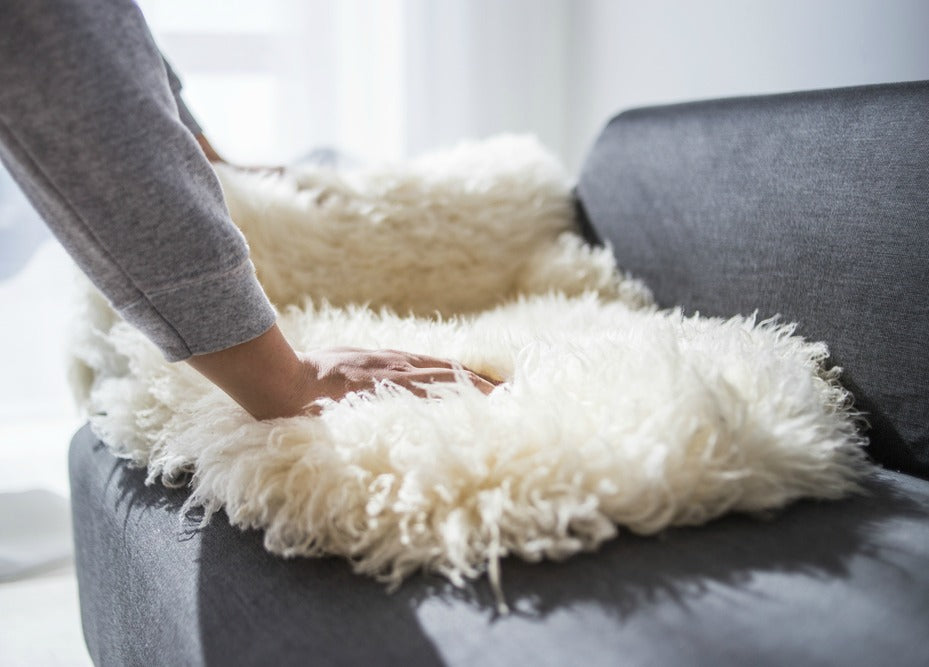2021 Winter Decorating Ideas
It may seem odd to plan winter decorating in mid-summer but, for do-it-yourselfers, starting early lets you think about your tastes, needs and budget. Top designers are putting together their winter portfolios that showcase trending winter decorating ideas for 2021. Here are a few that will make your home cozy and bright as the seasons change.
Change the Color Palette
As part of the process of selecting colors for interiors, designers take into consideration how people respond to color. Known as color psychology, different colors affect moods, thoughts and the way you feel. The light, airy colors of summer make winters feel colder. Designers are featuring rich, saturated colors that give a feeling of warmth and comfort. Deep oranges with brown undertones, navy blue, classic grey and red wine colors, from dusky purple to the rosy hues of syrah, are high on the list of this year's colors. Other featured colors include dark green and jewel tones, such as ruby, emerald and amethyst.
Many designers are going for dark wall colors contrasted with rich accents and metallic tones. If your walls are neutral, consider painting one a dark color, such as matte black. If black is not appealing, try navy blue, a top favorite this year. The deep hues serve as a neutral background that work well with all other colors. Its many nuances of tone evoke a timeless elegance that sets a backdrop for bursts of glinting metallic hues of gold, brass, silver or bronze. Since navy blue is a relaxing shade, spice it up with cherry reds, orange, yellows or emerald.
Add Texture

Along with color, texture adds depth and interest to an interior. Rich fabrics, such as wool, cashmere, velvet and faux fur, look and feel warm. Add them to floors, sofas, chairs, window coverings and beds. Layering also gives a feeling of warmth.
Getting out of bed on a cold winter morning is easier if bare feet land on the warmth of a carpet instead of cold floors. Layer rugs over bare stone, tile or wood floors. Tuck the edges of large area rugs under furniture to add texture and warmth, and top them with smaller throw rugs or sheepskins for visual interest. If you have carpet already, accentuate your new color palette with area rugs in shades that add zing.
Rugs don't need to be confined to the floor. Rugs can serve as an addition to wall art or as a focal point. Try hanging a rug on a wall to break up a large expanse of flat surface. Select a rug that complements the style of your décor. Colorful flat weave oriental kilims, tufted Scandinavian weavings in bold colors, subtly designed Moroccan rugs or rough-textured sisal rugs each makes a unique decorative statement.
Lighting also adds texture and depth to a space. Some materials, such as metals, glass and ceramics, reflect light. Others, such as wood and terracotta, absorb light. Pendant lights, chandeliers, candles and table lamps each create a distinctive type of light that contributes to the layers of the room.
Accessorize
Winter home decorating need not be expensive or time-consuming. If you don't want to go to the trouble of painting walls, use accessories to warm up your space with color and texture. Drape throws, blankets or shawls over a sofa, chair or bed. They look inviting and are soft and warm to cuddle under. The chunky texture of knitted throws and wraps adds a homey warmth to any room. Knits are popular as decorations as well, such as stars, wreaths, pillows, tree skirts and ornaments. Old sweaters can be repurposed into textured wraps for vases and bottles.
One of the easiest ways to influence the look of a room is to change pillow covers. If the rest of your décor is understated, go with bright colors. Select a palette that complements winter hues, such as cranberry, grape, olive green or maple. Combine patterns and solids. Contrast classic patterns of checks and tartans in reds and greens with solids of off-white, mustard or teal. Using both warm and cool colors balances the look.
Accessorize your dining room with seasonal changes of table runners, tablecloths, napkins, candles and chair cushions. If your dining chairs look worn, cover them. Slipcovers come in many colors and patterns, letting you refresh furnishings and tie elements of the room together with minimal expense.
Make Window Treatments Stand Out

Window treatments make a strong decorative statement. They can be used as the defining decorative element of a room or to complement the overall scheme. All the elements of design can be expressed at the window with texture, color, pattern and light. In addition, curtains are inexpensive and easy to change from season to season.
Curtains do more than add beauty to a room. Layering window treatments contributes to the design style while reaping the benefits of controlling light and heat. Blackout curtains modulate light. Thermal curtains reduce drafts and impede the transfer of heat around windows. Sheers next to the glass let sunlight in during the daytime, making use of the heat and light of the sun. Heavier draperies inside the room provide privacy and shut out cold air when needed.
Think through your needs and the look you want to create as you select window treatments. Shutters, drapes, Roman shades and mini-blinds each have a distinctive look that can be used to complement décor or add contrast. Hanging puddled drapery at windows softens the starkness of minimalist décor. Using a neutral, solid curtain tones down the busyness of a Bohemian look. Top treatments, such as valances and pelmets, can be used alone or paired with another window treatment.
The hardware used to hang curtains or shades enhances the room's design scheme. Cast iron, bronze, clear acrylic and stainless steel reflect light differently and change the look of the window. Finials, tie-backs, rods and hooks add a finished look to the ensemble.
When selecting curtains, take into account the details of the room. Prints give a sense of movement. Silks and velvet drape sensuously. Grommet-topped curtains hang more stiffly from the rod but are more casual in look. Match curtains to cushions, lamp shades or other textiles in the room to create a cohesive look.
Use Nature's Bounty
Designers also include elements of nature in their winter decorating ideas to add texture, color, scent and beauty. Potted plants can be used year-round as part of the interior decor. Winter plants, such as poinsettia, laurel, berries and amaryllis, add a pop of color. Intertwine branches of fir, pine cones or holly on a mantel or windowsill. Drape fresh garlands of cedar around windows, doorways or along stair rails. Wreaths are not only for Christmas. Weave clusters of pine with ribbon and juniper berries into attractive shapes and hang on the front door, above doorways or on blank wall space throughout the house.
Don't forget the enjoyment of natural scents. Vanilla, cinnamon, clove and orange blended together contribute to the sensory pleasure of a cozy winter interior.
With a few simple changes, you can transform your living area into a vibrant, enjoyable space full of color, light and texture. Start now to plan, design and create your winter home decorating scheme that you and your loved ones will enjoy during the cold months of the year.
Browse Thermal Curtains By Color
Recommended For You
5.0 / 5.0
17 reviews- Zuri/Natural-White
- Zuri/Gray-Blue
- Zuri/Light Green
- Zuri/Light Pink
- Zuri/Yellow
- Zuri/Sand
4.98 / 5.0
47 reviews- Solene/Purple
- Solene/Dark Gray
- Solene/Light Beige
- Solene/Dark Beige
- Solene/Sand
- Solene/Light Gray
- Solene/Sky Blue
- Solene/Baby Blue
4.91 / 5.0
11 reviews- Olivia/White
- Olivia/Khaki
- Olivia/Light Gray
- Olivia/Brownish
- Olivia/Dark Gray
- Olivia/Mint Green
- Olivia/Navy Blue
- Olivia/Blue
- Olivia/Cream
- Olivia/Dark Brown
- Olivia/Gray
- Olivia/Pink
- Olivia/Grass Green
- Olivia/Dark Green
- Olivia/Black
5.0 / 5.0
26 reviews- Sienna/Black
- Sienna/Light Gray
- Sienna/White
- Sienna/Beige Yellow
4.95 / 5.0
22 reviews- Isabel/Bluish Gray
- Isabel/Cream White
- Isabel/Grayish White
- Isabel/Dark Gray
- Isabel/Sky Blue
- Isabel/Coffee
5.0 / 5.0
4 reviews- Charlotte/Olive Green
- Charlotte/Beige
- Charlotte/Dark Khaki
- Charlotte/Brown
- Charlotte/Lime Green
- Charlotte/Blue Gray
- Charlotte/Peach Pink
- Charlotte/Brownish
- Charlotte/Light Gray
- Charlotte/Steel Gray
- Charlotte/Smokey Purple
- Charlotte/White
- Charlotte/Green
- Charlotte/Orange
- Charlotte/Dark blue
4.33 / 5.0
3 reviews- Emma/Natural
- Emma/Chocolate Natural
- Emma/Pine Natural
- Emma/Gray
- Emma/Ochre Natural
5.0 / 5.0
5 reviews- Celeste/Grayish White
- Celeste/Dark Beige
- Celeste/Dark Gray
- Celeste/Light Gray
- Celeste/Light Beige
- Celeste/Dark Brown
- Celeste/Sky Blue
- Celeste/Blue
- Celeste/Navy Blue
- Celeste/Gray
- Sophia/White
- Sophia/Light Beige
- Sophia/Wheat
- Sophia/Pink
- Sophia/Lake Blue
- Sophia/Navy blue
- Sophia/Light Gray
- Sophia/Dark Gray
- Sophia/Coffee
- Sophia/Brown
- Sophia/Grass Green
- Sophia/Orange
- Sophia/Black
- Sophia/Aquamarine
4.96 / 5.0
25 reviews- Clara/Natural
- Clara/Light Gray
4.92 / 5.0
13 reviews- Heloise/Navy Blue
- Heloise/Grayish White
- Heloise/Light Brown
- Heloise/Sand
- Heloise/Light Gray
- Heloise/Gray
- Heloise/Rose
- Heloise/Dark Blue
- Heloise/Light Blue
- Heloise/Baby Blue
- Heloise/Light Green
- Heloise/Grass Green
- Heloise/Dark Green
- Heloise/Coffee
- Elodie/Dark Gray
- Elodie/Black
- Elodie/Light Gray
- Elodie/Pink
- Elodie/Green
- Elodie/Beige
- Elodie/Gray
- Elodie/Light Coffee
- Elodie/Brown
- Elodie/Blue
4.8 / 5.0
5 reviews- Luna/Dark Gray
- Luna/Light Gray
- Luna/Black
- Luna/Natural
- Nicolette/Light Beige
- Nicolette/Light Gray
- Nicolette/Grayish White
- Nicolette/Brown
- Nicolette/Cinnamon
- Nicolette/Coffee
- Nicolette/Pinkish Purple
- Nicolette/Light Blue
- Nicolette/Lake Blue
- Nicolette/Blue
- Nicolette/Dark Blue
- Nicolette/Dark Brown
- Nicolette/Dark Gray
- Aspasia/Cream White
- Aspasia/Gray
- Aspasia/Light Gray
- Aspasia/Blue Gray
- Aspasia/Taupe
- Aspasia/Khaki
- Aspasia/Rose
- Aspasia/Matche Green
- Aspasia/Dark Blue
- Cecilia/Grass Green
- Cecilia/Cream White
- Cecilia/Tea Milk
- Cecilia/Light Gray
- Cecilia/Gray
- Cecilia/Dark Gray
- Cecilia/Haze Blue
- Cecilia/Kahki
- Cecilia/Dark Brown
- Yvonne/Creamy Cloud
- Yvonne/Warm Beige
- Yvonne/Latte Brown
- Yvonne/Peach Pink
- Yvonne/Silver Grey
- Yvonne/Slate Grey
- Yvonne/Walden Blue
- Yvonne/Royal Blue
- Yvonne/Olive Green
- Yvonne/Avocado Green
- Yvonne/Alice Blue
- Ash1
- Ash2
- Salome/Green
- Salome/White
- Salome/Beige
- Salome/Light Gray
- Salome/Dark Gray




























